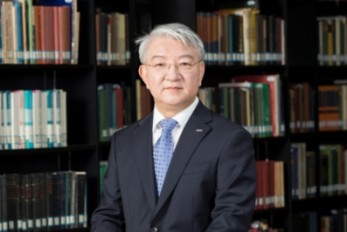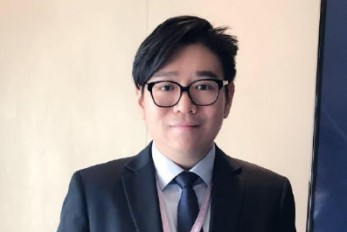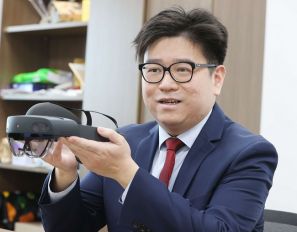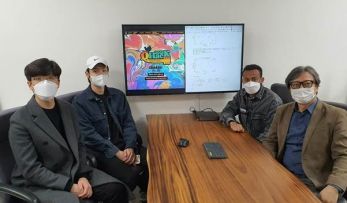Kaist
Korean

People News
-

Professor Sang Su Lee’s Team Wins Seven iF Design ..
Professor Sang Su Lee from the Department of Industrial Design and his team’s five apps made in collaboration with NH Investment and Securities won iF Design Awards in the fields of UI, UX, service design, product design, and communication. These apps are now offered as NH Investment and Securities mobile applications. The iF Design Awards recognize top quality creativity in product design, communication, packaging, service design and concepts, and architecture and interior design, as well as user experience (UX) and interface for digital media (UI). In the field of UI, ‘Gretell’ is a mobile stock investment app service designed by Lee and his team to support investors struggling to learn about investing by archiving personalized information. Gretell provides investment information including news and reports. Users learn, evaluate, and leave comments. This shows both quantitative and qualitative indications, leading to rational decision-making. Other user’s comments are shared to reduce confirmation bias. Through this process, Gretell helps users who are impulsive or easily swayed by others’ opinions to grow as independent investors. ‘Bright’ is another app created by Lee’s team. It helps people exercise their rights as shareholders. As the need to exercise shareholders’ rights increases, many people are frustrated that investors with a small number of shares don’t have a lot of power. Bright provides a space for shareholders to share their opinions and brings people together so that individuals can be more proactive as shareholders. The Integrated Power of Attorney System (IPAS) expands the chances for shareholders to exercise their rights and allows users to submit proposals that can be communicated during the general meeting. Bright fosters influential shareholders, responsible companies, and a healthy society. For communications, ‘Rewind’ is a stock information services app that visualizes past stock charts through sentiment analysis. Existing services focus on numbers, while Rewind takes a qualitative approach. Rewind analyzes public sentiment toward each event by collecting opinions on social media and then visualizes them chronologically along with the stock chart. Rewind allows users to review stock market movements and record their thoughts. Users can gain their own insights into current events in the stock market and make wiser investment decisions. The intuitive color gradient design provides a pleasant and simplified information experience. In the area of interfaces for digital media and service design, ‘Groo’ is a green bond investing service app that helps users participate in green investment though investing in green bonds that support green projects for environmental improvement. Not restricted to trading bonds, Groo joins users in the holistic experience of green investing, from taking an interest in environmental issues to confirming the impact of the investment. Next, ‘Modu’ is a story-based empathy expression training game for children with intellectual disabilities. Modu was developed to support emotion recognition and empathy behavior training in children with mild intellectual disabilities (MID) and borderline intellectual functioning (BIF). Finally, the diving VR device for neutral buoyancy training, ‘Blow-yancy’, also made winner’s list. The device mimics scuba diving training without having to go into the water, therefore beginner divers are able getting feeling of diving while remaining perfectly safe and not harming any corals. It is expected that the device will be able to help protect at-risk underwater ecosystems.
-

VP Sang Yup Lee Receives Honorary Doctorate from D..
< Distinguished Professor Sang Yup Lee (left) and DTU President Anders Bjarklev during the DTU Commemoration Day 20200 on April 29. > Vice President for Research, Distinguished Professor Sang Yup Lee at the Department of Chemical & Biomolecular Engineering, was awarded an honorary doctorate from the Technical University of Denmark (DTU) during the DTU Commemoration Day 2022 on April 29. The event drew distinguished guests, students, and faculty including HRH The Crown Prince Frederik Andre Henrik Christian and DTU President Anders Bjarklev. Professor Lee was recognized for his exceptional scholarship in the field of systems metabolic engineering, which led to the development of microcell factories capable of producing a wide range of fuels, chemicals, materials, and natural compounds, many for the first time. Professor Lee said in his acceptance speech that KAIST’s continued partnership with DTU in the field of biotechnology will lead to significant contributions in the global efforts to respond to climate change and promote green growth. DTU CPO and CSO Dina Petronovic Nielson, who heads DTU Biosustain, also lauded Professor Lee saying, “It is not only a great honor for Professor Lee to be induced at DTU but also great honor for DTU to have him.” Professor Lee also gave commemorative lectures at DTU Biosustain in Lingby and the Bio Innovation Research Institute at the Novo Nordisk Foundation in Copenhagen while in Denmark. DTU, one of the leading science and technology universities in Europe, has been awarding honorary doctorates since 1921, including to Nobel laureate in chemistry Professor Frances Arnold at Caltech. Professor Lee is the first Korean to receive an honorary doctorate from DTU.
-

A New Strategy for Active Metasurface Design Provi..
The new strategy displays an unprecedented upper limit of dynamic phase modulation with no significant variations in optical amplitude An international team of researchers led by Professor Min Seok Jang of KAIST and Professor Victor W. Brar of the University of Wisconsin-Madison has demonstrated a widely applicable methodology enabling a full 360° active phase modulation for metasurfaces while maintaining significant levels of uniform light amplitude. This strategy can be fundamentally applied to any spectral region with any structures and resonances that fit the bill. Metasurfaces are optical components with specialized functionalities indispensable for real-life applications ranging from LIDAR and spectroscopy to futuristic technologies such as invisibility cloaks and holograms. They are known for their compact and micro/nano-sized nature, which enables them to be integrated into electronic computerized systems with sizes that are ever decreasing as predicted by Moore’s law. < Figure1.The metasurface designed by the team that demonstrates complete 2π tunable phase modulation utilizing the avoided crossing of two resonances. > < Figure2. a: Complex reflection coefficient trajectories with different mobility values for the graphene sheet case. Full 2π phase modulation does not occur without the avoided crossing with graphene plasmons, despite the increasing mobilities and therefore the decreasing linewidths. b: Complex reflection coefficient trajectories with different mobility values for the graphene ribbon case.) > In order to allow for such innovations, metasurfaces must be capable of manipulating the impinging light, doing so by manipulating either the light’s amplitude or phase (or both) and emitting it back out. However, dynamically modulating the phase with the full circle range has been a notoriously difficult task, with very few works managing to do so by sacrificing a substantial amount of amplitude control. Challenged by these limitations, the team proposed a general methodology that enables metasurfaces to implement a dynamic phase modulation with the complete 360° phase range, all the while uniformly maintaining significant levels of amplitude. The underlying reason for the difficulty achieving such a feat is that there is a fundamental trade-off regarding dynamically controlling the optical phase of light. Metasurfaces generally perform such a function through optical resonances, an excitation of electrons inside the metasurface structure that harmonically oscillate together with the incident light. In order to be able to modulate through the entire range of 0-360°, the optical resonance frequency (the center of the spectrum) must be tuned by a large amount while the linewidth (the width of the spectrum) is kept to a minimum. However, to electrically tune the optical resonance frequency of the metasurface on demand, there needs to be a controllable influx and outflux of electrons into the metasurface and this inevitably leads to a larger linewidth of the aforementioned optical resonance. The problem is further compounded by the fact that the phase and the amplitude of optical resonances are closely correlated in a complex, non-linear fashion, making it very difficult to hold substantial control over the amplitude while changing the phase. The team’s work circumvented both problems by using two optical resonances, each with specifically designated properties. One resonance provides the decoupling between the phase and amplitude so that the phase is able to be tuned while significant and uniform levels of amplitude are maintained, as well as providing a narrow linewidth. The other resonance provides the capability of being sufficiently tuned to a large degree so that the complete full circle range of phase modulation is achievable. The quintessence of the work is then to combine the different properties of the two resonances through a phenomenon called avoided crossing, so that the interactions between the two resonances lead to an amalgamation of the desired traits that achieves and even surpasses the full 360° phase modulation with uniform amplitude. Professor Jang said, “Our research proposes a new methodology in dynamic phase modulation that breaks through the conventional limits and trade-offs, while being broadly applicable in diverse types of metasurfaces. We hope that this idea helps researchers implement and realize many key applications of metasurfaces, such as LIDAR and holograms, so that the nanophotonics industry keeps growing and provides a brighter technological future.” The research paper authored by Ju Young Kim and Juho Park, et al., and titled "Full 2π Tunable Phase Modulation Using Avoided Crossing of Resonances" was published in Nature Communications on April 19. The research was funded by the Samsung Research Funding & Incubation Center of Samsung Electronics. -Publication: Ju Young Kim, Juho Park, Gregory R. Holdman, Jacob T. Heiden, Shinho Kim, Victor W. Brar, and Min Seok Jang, “Full 2π Tunable Phase Modulation Using Avoided Crossing of Resonances” Nature Communications on April 19 (2022). doi.org/10.1038/s41467-022-29721-7 -Profile Professor Min Seok Jang School of Electrical Engineering KAIST
-

LightPC Presents a Resilient System Using Only Non..
Lightweight Persistence Centric System (LightPC) ensures both data and execution persistence for energy-efficient full system persistence A KAIST research team has developed hardware and software technology that ensures both data and execution persistence. The Lightweight Persistence Centric System (LightPC) makes the systems resilient against power failures by utilizing only non-volatile memory as the main memory. “We mounted non-volatile memory on a system board prototype and created an operating system to verify the effectiveness of LightPC,” said Professor Myoungsoo Jung. The team confirmed that LightPC validated its execution while powering up and down in the middle of execution, showing up to eight times more memory, 4.3 times faster application execution, and 73% lower power consumption compared to traditional systems. Professor Jung said that LightPC can be utilized in a variety of fields such as data centers and high-performance computing to provide large-capacity memory, high performance, low power consumption, and service reliability. In general, power failures on legacy systems can lead to the loss of data stored in the DRAM-based main memory. Unlike volatile memory such as DRAM, non-volatile memory can retain its data without power. Although non-volatile memory has the characteristics of lower power consumption and larger capacity than DRAM, non-volatile memory is typically used for the task of secondary storage due to its lower write performance. For this reason, nonvolatile memory is often used with DRAM. However, modern systems employing non-volatile memory-based main memory experience unexpected performance degradation due to the complicated memory microarchitecture. To enable both data and execution persistent in legacy systems, it is necessary to transfer the data from the volatile memory to the non-volatile memory. Checkpointing is one possible solution. It periodically transfers the data in preparation for a sudden power failure. While this technology is essential for ensuring high mobility and reliability for users, checkpointing also has fatal drawbacks. It takes additional time and power to move data and requires a data recovery process as well as restarting the system. In order to address these issues, the research team developed a processor and memory controller to raise the performance of non-volatile memory-only memory. LightPC matches the performance of DRAM by minimizing the internal volatile memory components from non-volatile memory, exposing the non-volatile memory (PRAM) media to the host, and increasing parallelism to service on-the-fly requests as soon as possible. The team also presented operating system technology that quickly makes execution states of running processes persistent without the need for a checkpointing process. The operating system prevents all modifications to execution states and data by keeping all program executions idle before transferring data in order to support consistency within a period much shorter than the standard power hold-up time of about 16 minutes. For consistency, when the power is recovered, the computer almost immediately revives itself and re-executes all the offline processes immediately without the need for a boot process. The researchers will present their work (LightPC: Hardware and Software Co-Design for Energy-Efficient Full System Persistence) at the International Symposium on Computer Architecture (ISCA) 2022 in New York in June. More information is available at the CAMELab website (http://camelab.org). < Figure 1. Customized system prototype (left: System prototype, Right: Implementation view) > < Figure 2. Overview of the proposed LightPC > < Figure 3. Energy and performance of the LightPC/LegacyPC (Right: Cycle norm. to legacy PC) > -Profile: Professor Myoungsoo Jung Computer Architecture and Memory Systems Laboratory (CAMEL) http://camelab.org School of Electrical Engineering KAIST
-

Energy-Efficient AI Hardware Technology Via a Brai..
Researchers demonstrate neuromodulation-inspired stashing system for the energy-efficient learning of a spiking neural network using a self-rectifying memristor array < Image: A schematic illustrating the localized brain activity (a-c) and the configuration of the hardware and software hybrid neural network (d-e) using a self-rectifying memristor array (f-g). > Researchers have proposed a novel system inspired by the neuromodulation of the brain, referred to as a ‘stashing system,’ that requires less energy consumption. The research group led by Professor Kyung Min Kim from the Department of Materials Science and Engineering has developed a technology that can efficiently handle mathematical operations for artificial intelligence by imitating the continuous changes in the topology of the neural network according to the situation. The human brain changes its neural topology in real time, learning to store or recall memories as needed. The research group presented a new artificial intelligence learning method that directly implements these neural coordination circuit configurations. Research on artificial intelligence is becoming very active, and the development of artificial intelligence-based electronic devices and product releases are accelerating, especially in the Fourth Industrial Revolution age. To implement artificial intelligence in electronic devices, customized hardware development should also be supported. However most electronic devices for artificial intelligence require high power consumption and highly integrated memory arrays for large-scale tasks. It has been challenging to solve these power consumption and integration limitations, and efforts have been made to find out how the human brain solves problems. To prove the efficiency of the developed technology, the research group created artificial neural network hardware equipped with a self-rectifying synaptic array and algorithm called a ‘stashing system’ that was developed to conduct artificial intelligence learning. As a result, it was able to reduce energy by 37% within the stashing system without any accuracy degradation. This result proves that emulating the neuromodulation in humans is possible. Professor Kim said, "In this study, we implemented the learning method of the human brain with only a simple circuit composition and through this we were able to reduce the energy needed by nearly 40 percent.” This neuromodulation-inspired stashing system that mimics the brain’s neural activity is compatible with existing electronic devices and commercialized semiconductor hardware. It is expected to be used in the design of next-generation semiconductor chips for artificial intelligence. This study was published in Advanced Functional Materials in March 2022 and supported by KAIST, the National Research Foundation of Korea, the National NanoFab Center, and SK Hynix. -Publication: Woon Hyung Cheong, Jae Bum Jeon†, Jae Hyun In, Geunyoung Kim, Hanchan Song, Janho An, Juseong Park, Young Seok Kim, Cheol Seong Hwang, and Kyung Min Kim (2022) “Demonstration of Neuromodulation-inspired Stashing System for Energy-efficient Learning of Spiking Neural Network using a Self-Rectifying Memristor Array,” Advanced Functional Materials March 31, 2022 (DOI: 10.1002/adfm.202200337) -Profile: Professor Kyung Min Kim http://semi.kaist.ac.kr https://scholar.google.com/citations?user=BGw8yDYAAAAJ&hl=ko Department of Materials Science and Engineering KAIST
-

Machine Learning-Based Algorithm to Speed up DNA S..
The algorithm presents the first full-fledged, short-read alignment software that leverages learned indices for solving the exact match search problem for efficient seeding < Image:Scientists from KAIST develops new machine-learning-based approach to speed up DNA sequencing. > The human genome consists of a complete set of DNA, which is about 6.4 billion letters long. Because of its size, reading the whole genome sequence at once is challenging. So scientists use DNA sequencers to produce hundreds of millions of DNA sequence fragments, or short reads, up to 300 letters long. Then the DNA sequencer assembles all the short reads like a giant jigsaw puzzle to reconstruct the entire genome sequence. Even with very fast computers, this job can take hours to complete. A research team at KAIST has achieved up to 3.45x faster speeds by developing the first short-read alignment software that uses a recent advance in machine-learning called a learned index. The research team reported their findings on March 7, 2022 in the journal Bioinformatics. The software has been released as open source and can be found on github (https://github.com/kaist-ina/BWA-MEME). Next-generation sequencing (NGS) is a state-of-the-art DNA sequencing method. Projects are underway with the goal of producing genome sequencing at population scale. Modern NGS hardware is capable of generating billions of short reads in a single run. Then the short reads have to be aligned with the reference DNA sequence. With large-scale DNA sequencing operations running hundreds of next-generation sequences, the need for an efficient short read alignment tool has become even more critical. Accelerating the DNA sequence alignment would be a step toward achieving the goal of population-scale sequencing. However, existing algorithms are limited in their performance because of their frequent memory accesses. BWA-MEM2 is a popular short-read alignment software package currently used to sequence the DNA. However, it has its limitations. The state-of-the-art alignment has two phases – seeding and extending. During the seeding phase, searches find exact matches of short reads in the reference DNA sequence. During the extending phase, the short reads from the seeding phase are extended. In the current process, bottlenecks occur in the seeding phase. Finding the exact matches slows the process. The researchers set out to solve the problem of accelerating the DNA sequence alignment. To speed the process, they applied machine learning techniques to create an algorithmic improvement. Their algorithm, BWA-MEME (BWA-MEM emulated) leverages learned indices to solve the exact match search problem. The original software compared one character at a time for an exact match search. The team’s new algorithm achieves up to 3.45x faster speeds in seeding throughput over BWA-MEM2 by reducing the number of instructions by 4.60x and memory accesses by 8.77x. “Through this study, it has been shown that full genome big data analysis can be performed faster and less costly than conventional methods by applying machine learning technology,” said Professor Dongsu Han from the School of Electrical Engineering at KAIST. The researchers’ ultimate goal was to develop efficient software that scientists from academia and industry could use on a daily basis for analyzing big data in genomics. “With the recent advances in artificial intelligence and machine learning, we see so many opportunities for designing better software for genomic data analysis. The potential is there for accelerating existing analysis as well as enabling new types of analysis, and our goal is to develop such software,” added Han. Whole genome sequencing has traditionally been used for discovering genomic mutations and identifying the root causes of diseases, which leads to the discovery and development of new drugs and cures. There could be many potential applications. Whole genome sequencing is used not only for research, but also for clinical purposes. “The science and technology for analyzing genomic data is making rapid progress to make it more accessible for scientists and patients. This will enhance our understanding about diseases and develop a better cure for patients of various diseases.” The research was funded by the National Research Foundation of the Korean government’s Ministry of Science and ICT. -Publication Youngmok Jung, Dongsu Han, “BWA-MEME:BWA-MEM emulated with a machine learning approach,” Bioinformatics, Volume 38, Issue 9, May 2022 (https://doi.org/10.1093/bioinformatics/btac137) -Profile Professor Dongsu Han School of Electrical Engineering KAIST
-

Promoting metaverse initiatives with an active age..
Hong Kong-based professionals were provided a metaverse course by Professor Lik-Hang Lee in collaboration with the Hong Kong Productivity Council(HKPC) during the Spring 2022 semester. Inresponse to the growing need for virtual worlds and virtual-physical hybrid settings, "The Metaverse Course for Professionals" intends to cultivate world-class metaverse talent. The traing covered the parallel virtual world and how to exploit digitalization and industry in the metaverse era. The training was attended by R&D scientists, consultants, software engineers, and associated professionals from the HKPC. The students completed extensive courses on topics such as creating and executing virtual-physical blended environments, metaverse technologies and ecosystems, immersive smart cities, token economies, and intelligent industrialization in the metaverse age. < Figure 1. Media Coverage by HKPC regarding the KAIST's Metaverse course > Moreover, Professor Lee and his collaborators worldwide have conducted research stucies on building user0centric urban areas featuring virtual-physical blended experiences, also known as metaverse cities. His recent studies aim to strike a balance between user interactivity bandwidth and user mobilit in the metaverse cities. Some AR/VR-based gadgets and system solutions include EMG-based text entry with occupied hands [Ref.4] (Figure 2A), freehand interaction of content editing on mobile immersive experience [Ref.3] (Figure 2C), VR-driven design of human-drone interfaces [Ref.5] (Figure 2D), user authentication on mobile geadsets with gaze and footsteps [Ref.2] (Figure 2E), multi-modal metaverse between Earth and Mars [Ref.6], and to name but a few. When the metaverse services appear ubiquitously in our cities, the studies mentioned above enable users to convert their intentions into actions seamlessly in such immersive environments. < Figure 2. Smapshots of recent research on Augmented Reality(AR) and Virtual Reality(VR) >
-

Professor Lik-Hang Lee Offers Metaverse Course for..
< Professor Lik-Hang Lee > Professor Lik-Hang Lee from the Department of Industrial System Engineering will offer a metaverse course in partnership with the Hong Kong Productivity Council (HKPC) from the Spring 2022 semester to Hong Kong-based professionals. “The Metaverse Course for Professionals” aims to nurture world-class talents of the metaverse in response to surging demand for virtual worlds and virtual-physical blended environments. The HKPC’s R&D scientists, consultants, software engineers, and related professionals will attend the course. They will receive a professional certificate on managing and developing metaverse skills upon the completion of this intensive course. The course will provide essential skills and knowledge about the parallel virtual universe and how to leverage digitalization and industrialization in the metaverse era. The course includes comprehensive modules, such as designing and implementing virtual-physical blended environments, metaverse technology and ecosystems, immersive smart cities, token economies, and intelligent industrialization in the metaverse era. Professor Lee believes in the decades to come that we will see rising numbers of virtual worlds in cyberspace known as the ‘Immersive Internet’ that will be characterized by high levels of immersiveness, user interactivity, and user-machine collaborations. “Consumers in virtual worlds will create novel content as well as personalized products and services, becoming as catalyst for ‘hyperpersonalization’ in the next industrial revolution,” he said. Professor Lee said he will continue offering world-class education related to the metaverse to students in KAIST and professionals from various industrial sectors, as his Augmented Reality and Media Lab will focus on a variety of metaverse topics such as metaverse campuses and industrial metaverses. The HKPC has worked to address innovative solutions for Hong Kong industries and enterprises since 1967, helping them achieve optimized resource utilization, effectiveness, and cost reduction as well as enhanced productivity and competitiveness in both local and international markets. The HKPC has advocated for facilitating Hong Kong’s reindustrialization powered by Industry 4.0 and e-commerce 4.0 with a strong emphasis on R&D, IoT, AI, digital manufacturing. The Augmented Reality and Media Lab led by Professor Lee will continue its close partnerships with HKPC and its other partners to help build the epicentre of the metaverse in the region. Furthermore, the lab will fully leverage its well-established research niches in user-centric, virtual-physical cyberspace (https://www.lhlee.com/projects-8 ) to serve upcoming projects related to industrial metaverses, which aligns with the departmental focus on smart factories and artificial intelligence.
-

Professor June-Koo Rhee’s Team Wins the QHack Open..
< From left: Ju-young Ryu, Jeung-rak Lee, and Eyuel Elala in Professor June-Koo Rhee > The research team consisting of three master students Ju-Young Ryu, Jeung-rak Lee, and Eyel Elala in Professor June-Koo Rhee’s group from the KAIST IRTC of Quantum Computing for AI has won the first place at the QHack 2022 Open Hackathon Science Challenge. The QHack 2022 Open Hackathon is one of the world’s prestigious quantum software hackathon events held by US Xanadu, in which 250 people from 100 countries participate. Major sponsors such as IBM Quantum, AWS, CERN QTI, and Google Quantum AI proposed challenging problems, and a winning team is selected judged on team projects in each of the 13 challenges. The KAIST team supervised by Professor Rhee received the First Place prize on the Science Challenge which was organized by the CERN QTI of the European Communities. The team will be awarded an opportunity to tour CERN’s research lab in Europe for one week along with an online internship. The students on the team presented a method for “Leaning Based Error Mitigation for VQE,” in which they implemented an LBEM protocol to lower the error in quantum computing, and leveraged the protocol in the VQU algorithm which is used to calculate the ground state energy of a given molecule. Their research successfully demonstrated the ability to effectively mitigate the error in IBM Quantum hardware and the virtual error model. In conjunction, Professor June-Koo (Kevin) Rhee founded a quantum computing venture start-up, Qunova Computing(https://qunovacomputing.com), with technology tranfer from the KAIST ITRC of Quantum Computing for AI. Qunova Computing is one of the frontier of the quantum software industry in Korea.
-

KAA Recognizes 4 Distinguished Alumni of the Year
< Distinguished Professor Sukbok Chang, Hyunshil Ahn at the AI Economy Institute at the Korea Economic Daily, PSTech CEO Hwan-ho Sung, Samsung Electrocnis President Hark Kyu Park (from left) > The KAIST Alumni Association (KAA) recognized four distinguished alumni of the year during a ceremony on February 25 in Seoul. The four Distinguished Alumni Awardees are Distinguished Professor Sukbok Chang from the KAIST Department of Chemistry, Hyunshil Ahn, head of the AI Economy Institute and an editorial writer at The Korea Economic Daily, CEO Hwan-ho Sung of PSTech, and President Hark Kyu Park of Samsung Electronics. Distinguished Professor Sukbok Chang who received his MS from the Department of Chemistry in 1985 has been a pioneer in the novel field of ‘carbon-hydrogen bond activation reactions’. He has significantly contributed to raising Korea’s international reputation in natural sciences and received the Kyungam Academic Award in 2013, the 14th Korea Science Award in 2015, the 1st Science and Technology Prize of Korea Toray in 2018, and the Best Scientist/Engineer Award Korea in 2019. Furthermore, he was named as a Highly Cited Researcher who ranked in the top 1% of citations by field and publication year in the Web of Science citation index for seven consecutive years from 2015 to 2021, demonstrating his leadership as a global scholar. Hyunshil Ahn, a graduate of the School of Business and Technology Management with an MS in 1985 and a PhD in 1987, was appointed as the first head of the AI Economy Institute when The Korea Economic Daily was the first Korean media outlet to establish an AI economy lab. He has contributed to creating new roles for the press and media in the 4th industrial revolution, and added to the popularization of AI technology through regulation reform and consulting on industrial policies. PSTech CEO Hwan-ho Sung is a graduate of the School of Electrical Engineering where he received an MS in 1988 and a PhD in EMBA in 2008. He has run the electronics company PSTech for over 20 years and successfully localized the production of power equipment, which previously depended on foreign technology. His development of the world’s first power equipment that can be applied to new industries including semiconductors and displays was recognized through this award. Samsung Electronics President Hark Kyu Park graduated from the School of Business and Technology Management with an MS in 1986. He not only enhanced Korea’s national competitiveness by expanding the semiconductor industry, but also established contract-based semiconductor departments at Korean universities including KAIST, Sungkyunkwan University, Yonsei University, and Postech, and semiconductor track courses at KAIST, Sogang University, Seoul National University, and Postech to nurture professional talents. He also led the national semiconductor coexistence system by leading private sector-government-academia collaborations to strengthen competence in semiconductors, and continues to make unconditional investments in strong small businesses. KAA President Chilhee Chung said, “Thanks to our alumni contributing at the highest levels of our society, the name of our alma mater shines brighter. As role models for our younger alumni, I hope greater honours will follow our awardees in the future.”
-

Decoding Brain Signals to Control a Robotic Arm
Advanced brain-machine interface system successfully interprets arm movement directions from neural signals in the brain < Figure:Experimental paradigm. Subjects were instructed to perform reach-and-grasp movements to designate the locations of the target in three-dimensional space. (a) Subjects A and B were provided the visual cue as a real tennis ball at one of four pseudo-randomized locations. (b) Subjects A and B were provided the visual cue as a virtual reality clip showing a sequence of five stages of a reach-and-grasp movement. > Researchers have developed a mind-reading system for decoding neural signals from the brain during arm movement. The method, described in the journal Applied Soft Computing, can be used by a person to control a robotic arm through a brain-machine interface (BMI). A BMI is a device that translates nerve signals into commands to control a machine, such as a computer or a robotic limb. There are two main techniques for monitoring neural signals in BMIs: electroencephalography (EEG) and electrocorticography (ECoG). The EEG exhibits signals from electrodes on the surface of the scalp and is widely employed because it is non-invasive, relatively cheap, safe and easy to use. However, the EEG has low spatial resolution and detects irrelevant neural signals, which makes it difficult to interpret the intentions of individuals from the EEG. On the other hand, the ECoG is an invasive method that involves placing electrodes directly on the surface of the cerebral cortex below the scalp. Compared with the EEG, the ECoG can monitor neural signals with much higher spatial resolution and less background noise. However, this technique has several drawbacks. “The ECoG is primarily used to find potential sources of epileptic seizures, meaning the electrodes are placed in different locations for different patients and may not be in the optimal regions of the brain for detecting sensory and movement signals,” explained Professor Jaeseung Jeong, a brain scientist at KAIST. “This inconsistency makes it difficult to decode brain signals to predict movements.” To overcome these problems, Professor Jeong’s team developed a new method for decoding ECoG neural signals during arm movement. The system is based on a machine-learning system for analysing and predicting neural signals called an ‘echo-state network’ and a mathematical probability model called the Gaussian distribution. In the study, the researchers recorded ECoG signals from four individuals with epilepsy while they were performing a reach-and-grasp task. Because the ECoG electrodes were placed according to the potential sources of each patient’s epileptic seizures, only 22% to 44% of the electrodes were located in the regions of the brain responsible for controlling movement. During the movement task, the participants were given visual cues, either by placing a real tennis ball in front of them, or via a virtual reality headset showing a clip of a human arm reaching forward in first-person view. They were asked to reach forward, grasp an object, then return their hand and release the object, while wearing motion sensors on their wrists and fingers. In a second task, they were instructed to imagine reaching forward without moving their arms. The researchers monitored the signals from the ECoG electrodes during real and imaginary arm movements, and tested whether the new system could predict the direction of this movement from the neural signals. They found that the novel decoder successfully classified arm movements in 24 directions in three-dimensional space, both in the real and virtual tasks, and that the results were at least five times more accurate than chance. They also used a computer simulation to show that the novel ECoG decoder could control the movements of a robotic arm. Overall, the results suggest that the new machine learning-based BCI system successfully used ECoG signals to interpret the direction of the intended movements. The next steps will be to improve the accuracy and efficiency of the decoder. In the future, it could be used in a real-time BMI device to help people with movement or sensory impairments. This research was supported by the KAIST Global Singularity Research Program of 2021, Brain Research Program of the National Research Foundation of Korea funded by the Ministry of Science, ICT, and Future Planning, and the Basic Science Research Program through the National Research Foundation of Korea funded by the Ministry of Education. -Publication Hoon-Hee Kim, Jaeseung Jeong, “An electrocorticographic decoder for arm movement for brain-machine interface using an echo state network and Gaussian readout,” Applied Soft Computing online December 31, 2021 (doi.org/10.1016/j.asoc.2021.108393) -Profile Professor Jaeseung Jeong Department of Bio and Brain Engineering College of Engineering KAIST
-

Improving speech intelligibility with Privacy-Pres..
Privacy-Preserving AR system can augment the speaker's speech with real-life subtitles to overcome the loss of contextual cues caused by mask-wearing and social distancing during the COVID-19 pandemic. Degraded speech intelligibility induces face-to-face conversation participants to speak louder and more distinctively, exposing the content to potential eavesdroppers. Similarly, people with face masks deteriorate their speech intelligibility, especially during the post-covid-19 crisis. Augmented Reality (AR) can serve as an effective tool to visualise people conversations and promote speech intelligibility, known as speech augmentation. However, visualised conversations without proper privacy management can expose AR users to privacy risks. An international research team of Prof. Lik-Hang LEE in the Department of Industrial and Systems Engineering at KAIST and Prof. Pan HUI in Computational Media and Arts at Hong Kong University of Science and Technology employed a conversation-oriented Contextual Integrity (CI) principle to develop a privacy-preserving AR framework for speech augmentation. At its core, the framework, namely Theophany, establishes ad-hoc social networks between relevant conversation participants to exchange contextual information and improve speech intelligibility in real-time. < Figure 1: A real-life subtitle application with AR headsets > Theophany has been implemented as a real-life subtitle application in AR to improve speech intelligibility in daily conversations (Figure 1). This implementation leverages a multi-modal channel, such as eye-tracking, camera, and audio. Theophany transforms the user's speech into text and estimates the intended recipients through gaze detection. The CI Enforcer module evaluates the sentences' sensitivity. If the sensitivity meets the speaker's privacy threshold, the sentence is transmitted to the appropriate recipients (Figure 2). < Figure 2: Multi-modal Contextual Integrity Channel > Based on the principles of Contextual Integrity (CI), parameters of privacy perception are designed for privacy-preserving face-to-face conversations, such as topic, location, and participants. Accordingly, Theophany operation depends on the topic and session. Figure 3 demonstrates several illustrative conversation sessions: (a) the topic is not sensitive and transmitted to everybody in the user's gaze. (b) the topic is work-sensitive and only transmitted to the coworker. (c) the topic is sensitive and only transmitted to the friend in the user's gaze. A new friend entering the user's gaze only gets the textual transcription once a new session (topic) starts (d). (e) the topic is highly sensitive, and nobody gets the textual transcription. < Figure 3: Speech Augmentation in five illustrative sessions > Theophany within a prototypical AR system augments the speaker's speech with real-life subtitles to overcome the loss of contextual cues caused by mask-wearing and social distancing during the COVID-19 pandemic. The research was published in ACM Multimedia under the title of 'Theophany: Multi-modal Speech Augmentation in Instantaneous Privacy Channels' (DOI: 10.1145/3474085.3475507), being selected as one of the best paper award candidates (Top 5). Note that the first author is an alumnus from the Industrial and Systems Engineering Department at KAIST. Short Bio: Lik-Hang Lee received a PhD degree from SyMLab, Hong Kong University of Science and Technology, and the Bachelor's and M.Phil. degrees from the University of Hong Kong. He is currently an assistant professor (tenure-track) with the Korea Advanced Institute of Science and Technology (KAIST), South Korea, and the head of the Augmented Reality and Media Laboratory, KAIST. He has built and designed various human-centric computing specializing in augmented and virtual realities (AR/VR). In recent years, he has published more than 30 research papers on AR/VR at prestigious conferences such as ACM WWW, ACM IMWUT, ACM Multimedia, ACM CSUR, IEEE Percom, and so on. He also serves the research community, as TPCs, PCs and workshop organizers, at some prestigious venues, such as AAAI, IJCAI, IEEE PERCOM, ACM CHI, ACM Multimedia, ACM IMWUT, IEEE VR, etc. Photo:

